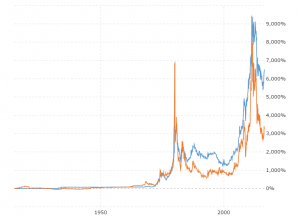Proof Palladium Eagle Hits the Market
In September of last year, 2017, the US Mint released its first palladium coin, following seven years of persistence by collectors. Coins of precious metals have been made of gold or silver for centuries, but for several decades now mints around the world have been issuing bullion and proof coins in other metals, such as platinum, and also palladium. The prices of metals in general have risen steadily, making these more unusual coins of more and more interest to collectors. The US Mint is not all in the lead on Palladium, since the Canadian Mint has been producing them more or less continuously since 1988.
The coin released last year was a bullion coin, but now, just a year later, and as promised then, a proof coin has been released for collectors. The design is the same as the bullion coin, but in a high-quality proof finish. Since the release of the coin last year the price of palladium has held well, unlike gold and silver, so these coins could be a more stable investment than other, much more volatile, metals. The price is currently just below $1,000 a troy ounce – which is the weight of the coin. It is notable that the 15,000 bullion coins stamped sold out on the first day of their release.
The design, as already noted, is the same as for the bullion coin. It is a particularly beautiful example of the coin-designer’s art, featuring work from the famous designer Adolph A. Weinman. Born in Germany, Weinman came to America in 1884, when he was 14. He studied as a sculptor in New York, under famous sculptors of the time. He created both large and small works, including pieces that can be seen at the Jefferson Memorial, and inside the Supreme Court building. He worked in a neo-classical style, but with flowing lines that suggest the Art Deco movement that was yet to come. He made a limited number of coin designs, and his Mercury quarter is the most famous. It is that design which has been reproduced for the obverse of the palladium coin.
The image is meant to be of Liberty, but it is often thought to be Mercury, because of the wings on either side of the head. However, the figure is wearing a Phrygian cap. This hat was worn by revolutionaries of the French revolution, and therefore became a symbol of ‘Liberty’. So Weinman’s choice was very appropriate. The ‘Mercury Quarter’ was in circulation from 1916 to 1945, and over 2 billion were struck. The engraved word, L I B E R T Y is written above the bust, while IN·GOD WE·TRUST is across the bottom. Adolph A. Weinman’s initials, as a ‘W’ with ‘A’ below it, are behind the figure, as well as ‘2018’.
On the reverse is another Weinman design from 1907. It was created for a gold medal awarded by the American Institute of Architects. It shows a high-relief eagle perched on a cliff, tearing at a small olive tree with its beak. The inscriptions on this side are, UNITED STATES of AMERICA, $25, 1 OZ. Pd .9995 FINE, and E PLURIBUS UNUM. ‘Pd’ is the chemical abbreviation for the metal Palladium. The coin has a very fine, collectible look that will shine in any collection, as well as adding metal value that should hold well.








